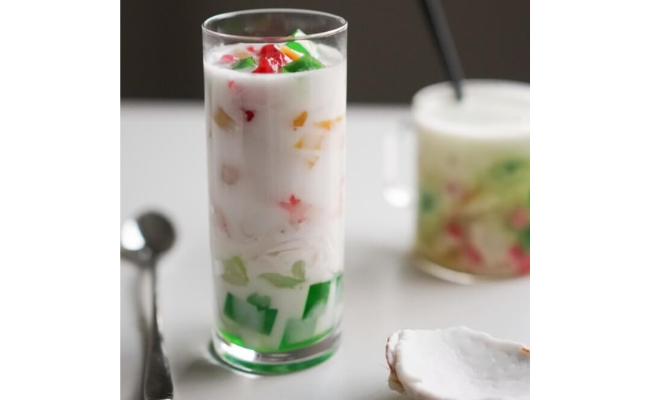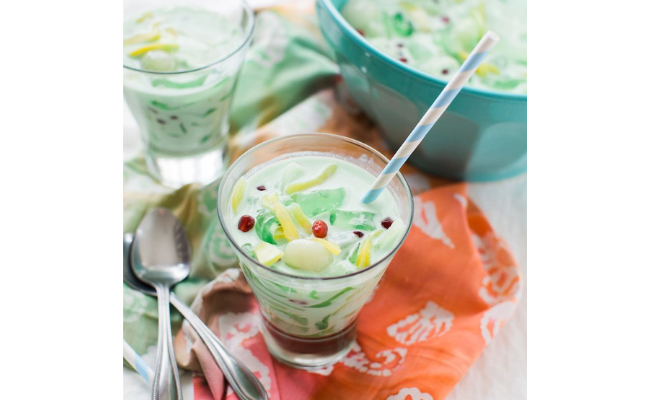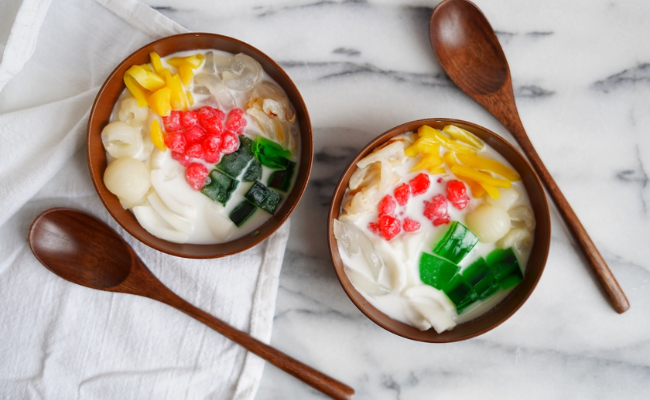Chè Thái: Everything You Need to Know
Eating a scoop of cool coconut milk, chewy jelly, jackfruit slices, and sweet lychee pieces sounds refreshing. Chè thái is a heavenly dessert in just one mouthful, rather than a sweet soup or fruit cocktail.
Have you ever had a sweet tooth but knew you would feel awful if you indulged in anything heavier like ice cream, cookies, or even a cupcake? Chè Thái is the solution.
When you’re ready to eat it in the middle of the night, you must spoon it into a bowl or cup. It is both an attractive and sensational feast and is perfect because of its colorful layers of jelly and sweet beans.
What is Chè Thái?

Che Thai is a delicious dessert that is both tropical and fruity. It is a Vietnamese variant of the Thai delicacy “Tub Tim Krop,” which combines coconut milk with water chestnuts. The water chestnuts are covered with tapioca starch, covered in red food dye, and cooked to give them a glossy crimson hue.
This recipe’s versatility allows you to use any fruit you prefer instead of the suggested ones. You could use mango, rambutan, mangosteen, or even durian because you would typically use exotic fruits.
The jellies are also quite simple to leave out or swap out. Add Ai Yu jelly, tapioca, or sago pearls in place of the red rubies. The options are limitless. Vietnamese desserts called “chè” are highly popular and frequently served in plastic cups. They are the ideal cool summer beverages.
It’s the ideal dessert at a big gathering because it’s so simple to prepare—you only need to cut the fruits and pour the coconut milk. Due to the lack of baking or cooking, it is foolproof.
Chè can be created with various ingredients, including kidney beans, tapioca, mung beans, black-eyed peas jelly (clear or grass), Vietnamese fruit (longans, lychees, or jackfruit), mango, durian, and coconut cream.
Chè Thái Variations
Other varieties contain salt, aloe vera, seaweed, lotus seeds, sesame seeds, sugar palm seeds, taro, cassava, and pandan leaf extract, among other components. Dumplings may also be a part of some types, such as chè trôi NC.
Chè is frequently made with various beans, tubers, or glutinous rice boiled in water and flavored with sugar. Coconut cream is frequently used as a garnish in southern Vietnam.
Fortunately, this dish is really easy to create because you can easily get canned tropical fruit to use in it. You may slurp or spoon it out, whichever you choose, and with every bite and sip, you’ll feel as cool as a cucumber while simultaneously being sweet and full.
Even though half and half are easily accessible, and there is no concern about milk curdling whenever the dessert is served cold, coconut milk is still used in traditional Thai desserts. Use coconut cream, or try Andrea if you want the extra coconut flavor.
Chè Thái contains 319 kcal calories, 55g Carbohydrates, 4g Protein, 11g Fat, 9g Saturated Fat, 14 mg Sodium, 708 mg Potassium, 4g Fiber, 27g Sugar, 65 IU Vitamin A, 120 mg Vitamin C, 29 mg Calcium, and 3 mg iron.
How to Make Chè Thái
What you’ll need:
- Toddy palm’s seed
- 1 can of jackfruit
- 1 can of longan
- 1 can of lychee
- 1 can of young coconut milk
- 1 jar of Ai-Ju jelly
- Coconut milk
Cook Time: 10 mins
Prep Time: 15 mins
The guidelines below will teach you how to make Che Thai.
Step 1
Place the tapioca strands in a punch bowl and add water to cover them. Set aside for 30 minutes to soak.
Step 2
Combine 2 teaspoons of agar, 3 tablespoons of sugar, and 1 3/4 cups water on high speed in a small pot until the mixture dissolves and comes to a boil. Put it into a small dish when it boils and let it there until it cools and becomes hard.
Step 3
Drain the strands, then place them in a small saucepan with just enough water to cover them by 1 1/2 inches. The strands should be cooked for about 25 minutes or until they are tender to the bite. Bring to a boil.
After around 10 minutes, they will still be chewy but resemble clear jewels. Drain them and place them in a water bowl to stop the strands from cooking and sticking together. Keep in the refrigerator for longer storage or up to 4 hours at room temperature.
Step 4
Open every can of fruit and reserve the syrup in a different container. The flavors can become fairly mixed if you combine the liquid from the cans.
Step 5
Cut the jackfruit into slices, lychee into big slices, and toddy palm into small slices. Longans come in quite compact packages, so keep them in their natural shape. In a big container, combine all the fruit.
Step 6
Slice the coconut meat after opening the coconut and reserving the juice. Then add the Ainu, and If your local grocery store doesn’t have Ai-Ju jelly, you can substitute grass jelly, which has a hint of green hue, or pandan jelly.
Step 7
Mix coconut juice and coconut milk in a different container. Add the juice syrup to the milk gradually, starting with 1/2 cup at a time, to sweeten it. Adapt to your preferences. Stir the meat, juice, and sweetened coconut milk into the large fruit container.
Step 8
Although most people prefer to chill the chè Thái for a few hours before serving, you can add smashed ice if you wish to serve it right away.
Conclusion
You can add actual or fake pomegranate seeds prepared from water chestnuts and tapioca starch for more texture and color contrast and a little extra work. It is preferable to add some ice cubes to chè thái before being served.



